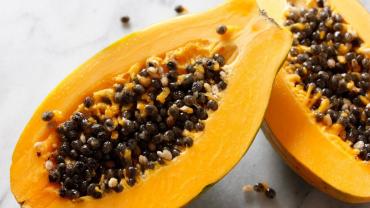
The growing popularity of Paleo low carbohydrate and ketogenic diets has led to increased awareness of the massive—and we might even say pathological—overconsumption of refined sugar. Whether it comes in the form of cane sugar beet sugar coconut sugar agave nectar or the whipping boy that bears the brunt of the backlash against sugar—high fructose corn syrup—sugar is sugar is sugar. And certainly many people do eat too much of it. So shifting the focus from cholesterol and saturated fat to refined sugar as an element of the modern diet that may be contributing to obesity and other chronic health conditions is well warranted.
Unfortunately a perhaps unintended consequence of the over-demonization of carbohydrate in general and simple sugars in particular is “fructophobia” – fear of fructose.
It’s undeniable that excessive amounts of fructose have detrimental effects on biomarkers for cardiometabolic health. However demonizing all sources of fructose because of the effects of overconsuming fructose isolated from its natural food matrix would be akin to rationalizing the demonization of nuts and seeds which are high in omega-6 fats because excessive omega-6 consumption from soybean corn safflower and cottonseed oils is associated with adverse health outcomes. Omega-6 (in the form of linoleic acid) is an essential fatty acid so we absolutely do need some in our diet even if only in a small amount. Fructose is not essential as there are no essential carbohydrates (not even glucose since we can synthesize it via gluconeogenesis). However just because fructose isn’t “essential” doesn’t mean it’s dietary enemy number 1. (Let’s face it: coffee and bacon aren’t essential either but there are a few million people who would beg to differ!) And just because a constant influx of fructose from soft drinks smoothies jams and jellies baked goods and other sources may have negative effects on metabolic health doesn’t mean small amounts when accompanied by water vitamins minerals and fiber in a whole food are a ticket to an early grave.
Case in point: papaya. This mouthwatering fruit was reputably referred to as “the fruit of the angels” by Christopher Columbus because it tasted so good. Like its tropical brethren such as bananas and mangoes the delicious and refreshing flavor of papaya might be a distant memory for those who seek to eradicate every molecule of fructose from their diet. But let’s take a look at this yellow-orange beauty and see what else it provides other than a dastardly monosaccharide our ancestors consumed for millennia long before the modern epidemics of obesity type 2 diabetes and cardiovascular disease. Fructose was surely a part of the human diet during Paleolithic times although it would have come exclusively in the form of honey and whole fruits. So it’s hard to argue that fructose per se is harmful. It’s much more likely that the problems associated with fructose consumption are the result of eating very large amounts of it much more often than would have been possible during most of human evolution.
Yes papaya is sweet but it’s not exactly a mega-sized bag of gummy bears. A 100-gram serving of papaya provides 5.9 total grams of sugar of which just 2.7 grams are fructose. (The rest is made up of 1.4 grams of glucose and 1.8 grams of sucrose.) And unlike a bottomless soda or a jelly donut papaya’s small amount of sugar comes along with vitamin C folate potassium and vitamin A precursor carotenoids.
But even better than that papaya flesh is a flavor party! It can be used in sweet or savory dishes and is popular in Southeast Asian cooking such as in this crunchy papaya salad with shrimp. Ripe juicy papaya is usually eaten raw but unripe green papaya is a common ingredient in Thai stews and curries and it can also be eaten raw in salads. For a refreshing summer appetizer or side dish try this spicy crab papaya salad for a little added protein.
As delicious as papaya flesh is the plentiful round black seeds hiding inside have special properties too. Both the fruit and the seeds contain papain a compound with protease effects. Papain is a common ingredient in digestive enzyme supplements for this reason and it’s also used as a meat tenderizer. (Papain may also be responsible for the noted anti-helminthic and anti-parasitic effects of papaya seed.) The seeds can also be used as a spice with a “sparky” flavor similar to that of black pepper mustard seed wasabi or horseradish. To use papaya seeds this way remove them from the fruit place them in a colander (with small holes!) and rinse away the gelatinous substance that covers them. Allow them to dry and once completely dried they can be ground in a spice grinder just as with any other seed or spice.
Individuals should stick with a level of carbohydrate consumption that fits in with healthy blood glucose and insulin management and maintenance of a healthy weight. But for many people this includes fruit in its whole fresh form (as opposed to smoothies or dried fruit). Let’s not throw the whole fruit baby out with the refined sugar bathwater.